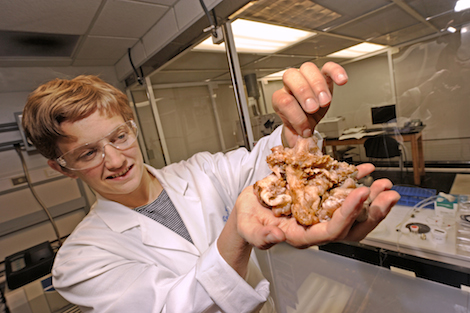
NEWS RELEASE
LAKE SUPERIOR STATE UNIVERSITY
*************************
SAULT STE. MARIE, MI – Anglers on the St. Mary’s have been pulling up large mats of an invader algae called Didymosphenia geminate, better know as didymo.
The unusual species of algae has been detected for the first time in Michigan, in the St. Mary’s River, according to Michigan Department of Environmental Quality.
The Department of Fisheries and Oceans Canada also confirms that didymo has been collecting on lamprey traps in the main rapids.
The algae resemble toilet tissue or wadded up paper and forms thick yellow-brown mats along river bottoms.
It is easy to miss when just a few cells are present, but it occasionally produces long, branching stalks creating nuisance conditions.
Contrary to a slimy appearance, the texture of didymo actually resembles that of wet wool.
Didymo cells have been recorded in western Lake Superior for decades, but didymo blooms have only been reported in recent years in a handful of streams on western Lake Superior.
Scientists suggest that Didymo may be expanding its range and experiencing novel environmental conditions that trigger the nuisance blooms.
However, the environmental triggers are still unclear.
According to Dr. Megan Kelly, LSSU environmental science professor, didymo is unlike other species of nuisance algae.
It typically thrives in cold, clear, flowing waters with low concentrations of nutrients such as phosphorus.
In some streams, didymo has formed thick mats that cover 30-100 percent of the streambed, which may have an impact on stream and river communities.
Prevention of the blooms in the St. Mary’s and surrounding streams is critical for the continued enjoyment of our aquatic resources, she said.
Anglers are being asked to help reduce the spread of didymo blooms by avoiding the use of felt-sole waders, and by drying and cleaning their fishing equipment after each use.
Felt-bottomed waders, in particular, are of concern because their texture aids the spread of didymo and other aquatic invasive species.
To prevent spread of aquatic invasives, anglers should thoroughly clean their waders and fishing gear with dish detergent in hot water and dry them for at least 48 hours or freeze them for 24 hours before using them in another water body.
Anglers can also consider replacing felt soles with an alternative, such as rubber-sole bottoms, which do not harbor aquatic invasives to the same extent.
LSSU’s Aquatic Research Laboratory is pursuing research funding to monitor environmental conditions in the St. Mary’s River in relation to future didymo outbreaks.
According to Dr. Ashley Moerke, LSSU biology professor and co-director of the lab, continuous water quality data are critical to better understand the dynamics of didymo blooms and provide recommendations to prevent future blooms and protect Great Lakes resources.
Meanwhile, Professor Kelly is also providing technical support for collaboration between Chippewa County 4-H, LSSU, and North Dakota State University (NDSU) that raises awareness of local water quality issues.
Chippewa County 4-H and Kelly want to form at least one team of junior high school students for this year's international WateRediscover competition.
The program accepts teams from all over the world and charges them to develop experiments that explore water quality in their region, and then share a proposed field study during a global video conference hosted at NDSU in November.
Teams compete on project methodologies and an ability to present proposed research to a global audience.
Students then implement proposed studies in the field through next spring.
Two former students of Kelly's - Rebecca Schewe, a graduate student at NDSU, and Emily Grasch, a summer ranger at Brimley State Park - are helping Chippewa County 4-H coordinator Melanie Greenfield organize Eastern Upper Peninsula teams.
Contact Greenfield at 906-635-6338 for details.
*************************
(PHOTO: Lake Superior State University environmental science professor Dr. Megan Kelly poses with a sample of Didymosphenia geminate, commonly known as “didymo” or “rock snot.” The unusual species of algae has been detected for the first time in Michigan, in the St. Mary’s River, according to Michigan Dept. of Environmental Quality. LSSU/John Shibley)
Previous SooToday coverage of this story: